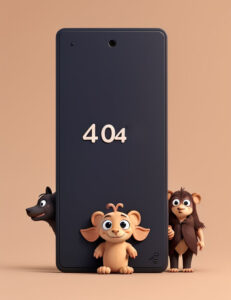Encountering an error page while browsing a website can be a frustrating experience. You were just getting into the groove, excited to explore, and suddenly, a roadblock appears. The traditional approach to error pages often leaves users bewildered, annoyed, and even tempted to leave the site altogether. But what if we told you that error pages could be transformed from frustrating obstacles into engaging interactions?
Components of an Effective Error Page
An effective error page goes beyond a mere display of error codes. It’s a strategic canvas that can turn a frustrating mishap into an opportunity for user engagement and retention. Crafting a user-friendly error page involves several key components that work together harmoniously to create a positive user experience.
At the heart of an effective error page is a clear and concise error message. Users should instantly understand what went wrong and why they’ve encountered the error page. Avoid using technical jargon that could confuse users further. Instead, use simple language that resonates with a broad audience, ensuring that even non-technical visitors grasp the issue at hand.
Text alone can be stark and impersonal. Incorporating relevant visuals on your error page can provide context and foster a sense of empathy. For instance, if a user stumbles upon a page that’s under construction, a construction worker icon or a playful image of a building site could help communicate the situation effectively. Visuals help bridge the gap between technology and human emotion.
Don’t let users hit a dead end. An error page should equip users with tools to navigate their way back to relevant content. A search bar allows users to quickly look for what they were originally seeking, while navigation links guide them to other sections of your website. This prevents frustration from escalating into user abandonment and encourages them to explore further.
An error page isn’t an isolated island; it’s still part of your website and brand experience. Maintain consistent branding elements, such as your logo and color scheme, to reassure users that they’re still interacting with your trusted brand. Additionally, your brand’s tone should remain consistent – whether it’s friendly, professional, or even humorous – to create a seamless experience across all touchpoints.
Errors are inevitable, but how you handle them can define your user relationships. Infuse a touch of empathy into your error page, acknowledging the inconvenience users are facing. A simple “We apologize for the inconvenience” can go a long way in making users feel heard and understood. This human touch can soften frustration and leave a positive impression.
By carefully incorporating these components into your error page design, you can transform what could be a stumbling block into an engaging moment that showcases your brand’s commitment to user satisfaction. Remember, it’s not just about addressing errors; it’s about turning them into opportunities for connection and growth.
Injecting Humor and Personality
 Imagine stumbling upon an error page that not only acknowledges the glitch but also manages to elicit a genuine chuckle. Injecting humor and personality into error pages has a transformative effect, converting frustration into a heartfelt smile. Brands such as GitHub and MailChimp have demonstrated the prowess of this approach by deploying quirky visuals and cleverly crafted messages, effectively disarming user frustration. However, it’s crucial that the chosen tone and level of humor resonate harmoniously with your brand’s unique identity and the seriousness of the encountered error.
Imagine stumbling upon an error page that not only acknowledges the glitch but also manages to elicit a genuine chuckle. Injecting humor and personality into error pages has a transformative effect, converting frustration into a heartfelt smile. Brands such as GitHub and MailChimp have demonstrated the prowess of this approach by deploying quirky visuals and cleverly crafted messages, effectively disarming user frustration. However, it’s crucial that the chosen tone and level of humor resonate harmoniously with your brand’s unique identity and the seriousness of the encountered error.
Mastering the art of humor within error pages requires a delicate balance. When skillfully executed, it can turn an inconvenience into an opportunity for user engagement and connection. Consider the potential impact of a well-placed joke or a relatable pop culture reference that resonates with your target audience. However, it’s essential to approach this strategy with caution, particularly when dealing with errors of higher significance. Maintaining professionalism and empathy in such cases ensures that humor doesn’t detract from the gravity of the situation.
Helpful Resources and Assistance
Being lost on an error page is bad enough, but feeling stranded is even worse. Offering users a lifeline in the form of helpful resources can turn frustration into a sense of support. Providing links to frequently asked questions (FAQs), contact information, and customer support details guides users toward potential solutions. In cases where immediate assistance is essential, contemplating the implementation of chatbots becomes pivotal. These virtual assistants can deliver instant responses, potentially resolving issues on the spot and ensuring that users feel attended to and valued.
Optimizing for Mobile and Other Devices
Errors are equal opportunity disruptors, affecting users across all types of devices. Therefore, your error page design should transcend device boundaries and provide a seamless experience for everyone. This underscores the importance of ensuring that your error pages are not only responsive but also optimized for a variety of devices, with particular emphasis on mobile devices.
Mobile users constitute a substantial chunk of internet traffic today, and overlooking their needs can have serious repercussions for user engagement and retention. A mobile-friendly error page isn’t just a nice-to-have feature; it’s a critical component of your user experience strategy.
If the error page isn’t properly optimized for mobile, it could lead to frustration due to distorted layouts, tiny text, and unclickable buttons. This frustration might prompt users to abandon your site altogether, resulting in lost opportunities and potential customers.
A well-optimized error page for mobile devices, on the other hand, retains the familiar look and feel of your brand while adapting to the smaller screen size. Text is legible, buttons are easily clickable, and navigation remains intuitive. This not only prevents user frustration but also demonstrates your commitment to providing a consistent and user-friendly experience across all platforms.
Incorporating responsive design principles and optimizing your error pages for mobile and other devices can pay off handsomely. It’s an investment in user satisfaction, engagement, and ultimately, your brand’s success. By acknowledging the significance of mobile users and catering to their needs even in moments of error, you’re laying a solid foundation for positive interactions and prolonged user relationships.
Utilizing Call-to-Action (CTA) Buttons
An error page doesn’t need to signal the end of a user’s journey. Instead, consider it an opportunity to guide users back on track through well-placed call-to-action (CTA) buttons. These buttons play a crucial role in redirecting users to the main site or other relevant sections, keeping them engaged despite encountering an error.
When crafting CTA buttons for your error page, it’s essential to infuse them with an element of intrigue and action. Use compelling phrases like “Continue Shopping” or “Explore More” to pique users’ curiosity and encourage them to continue exploring your website. By enticing users to take a specific action, you can prevent them from bouncing away in frustration.
Think of CTA buttons as signposts that help users navigate through their digital journey, even in the face of setbacks. While they may have encountered an error, the presence of these buttons reassures users that there’s still value to be found on your site. A well-executed CTA can effectively turn an error page into a stepping stone, guiding users back to a fulfilling experience.
Incorporating CTA buttons into your error page design doesn’t just offer a quick fix; it’s a strategic move to keep users engaged, foster exploration, and demonstrate your commitment to their experience. By leading users down a positive path, you’re not only transforming moments of frustration into opportunities for engagement but also enhancing the likelihood of user retention and brand loyalty.
Effective Error Page Designs
Taking a closer look at real-world examples of websites that have truly excelled in the realm of error page design can offer valuable lessons. One such illustration is Airbnb’s error page, which cleverly integrates an inviting visual of a birdhouse along with a simple yet sincere apology. Another instance can be found in GitHub’s “404 Not Found” page, where a playful nod suggests the missing page might have taken a cosmic journey to another planet. These instances eloquently demonstrate how error pages have the remarkable ability to create memorable interactions, even when faced with setbacks. Such strategic design choices not only alleviate user frustration but also showcase a brand’s commitment to user-centric experiences.
